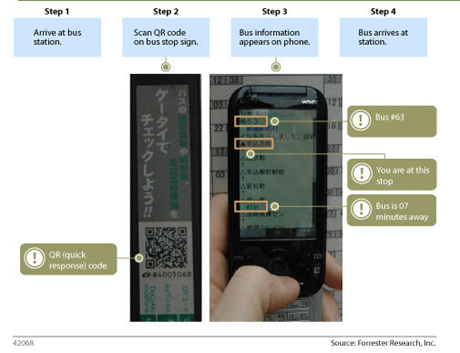North American wireless broadband REALLY needs these two Japanese innovations


I've been browsing through a new Forrester Research report entitled, "How Japanese Companies Guide Their Customers To Mobile Internet Experiences." That link is to the Executive Sumary.
In the report, Forrester analysts Jonathan Browne, Ron Rogowski and Steven Geller start out by noting that in any language, mobile search is (often) inaccurate. Check.
But then the authors present two fascinating Japanese innovations that get around mobile search's limitations by making it easier for mobile broadband (cell and Wi-Fi) users to get at the information or transactional mobile Web page they want without having to perform a search or navigate several levels down subject trees.
The authors refer to these services as "Using bar codes to link users to contextual support," and "Using wireless tags to push content directly from the urban environment."
The "bar code" solution is best for cell.
"Most camera phones in Japan include software that scans two-dimensional bar codes, known as QR (quick response) codes, which can contain data such as a Web site URL," the authors write. "Tokyo's metropolitan transportation bureau posts unique codes at hundreds of bus stops around the city that link commuters to journey planning tools, timetables, bus locations, and estimated wait times for each specific location."
As shown in the image at the top of this post, your cellphone's built-in bar code reader would scan the bar code at a specific transit stop. The scan would direct your cellphone's wireless broadband Web browser to a landing page where further, and quite specific info about the route that stops where you are would be available.
The "wireless tags" feature is probably best for (but not limited to) Wi-Fi-enabled notebook users.
In an endnote to a description of how this will work, the authors of this report write:
For an experimental project in Tokyo's Ginza shopping district, researchers from The University of Tokyo placed more than 1,200 RFID chips, 270 infrared spotlights, and 16 Wi-Fi stations on lampposts and in flower beds, stores, and subway tunnels.
Participants in the experiment carried dedicated devices that played media files and displayed content that was pushed to the devices based on the location of the participant. Thus, when a participant stood in front of a historical landmark, he would receive background information on that landmark.
So my question is, which cell and Wi-Fi service providers will team up with North American businesses, municipalities, and transit agencies to offer either of these two services?
How about either T-Mobile or Earthlink? Both are players in cell and Wi-Fi access. This would be a natural.
I'm excited. These could happen!